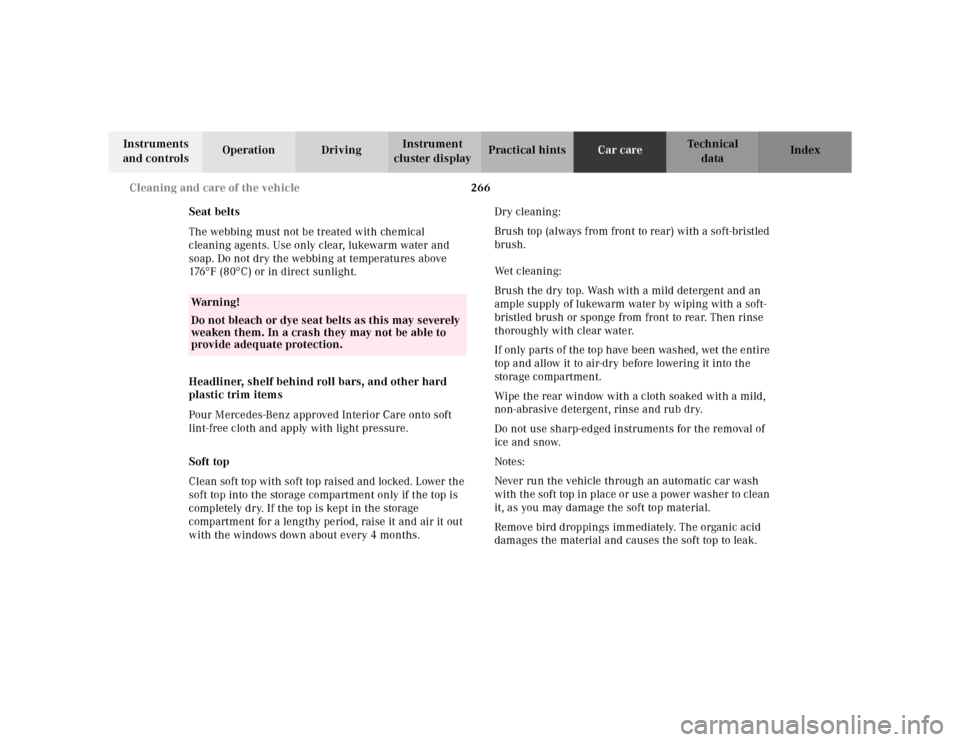Page 239 of 302

235 Tires, Wheels
Te ch n ica l
data Instruments
and controlsOperation DrivingInstrument
cluster displayPractical hintsCar care Index Tire inflation pressure
A table (see fuel filler flap) lists the tire inflation
pressures specified for Mercedes-Benz recommended
tires as well as for the varying operating conditions.
Important!
Tire pressure changes by approx. 1.5 psi (0.1 bar) per
18°F (10°C) of air temperature change. Keep this in
mind when checking tire pressure inside a garage -
especially in the winter.
Example:
If garage temperature = approx. +68°F (+20°C) and
ambient temperature = approx. +32°F (0°C) then the
adjusted air pressure = specified air pressure +3psi
(+0.2 bar).
Tire pressures listed for light loads are minimum values
offering high driving comfort. Increased inflation
pressures for heavy loads produce favorable handling
characteristics with lighter loads and are perfectly
permissible. The ride of the vehicle, however, will
become somewhat harder.
Tire temperature and pressure increase with the vehicle
speed. Tire pressure should therefore only be checked
and corrected on cold tires. Correct tire pressure in
Wa r n i n g !
Do not drive the vehicle while the wheel change
switch is activated since the vehicle suspension
will not function properly.Wa r n i n g !
The spare wheel rim is for temporary use only. Use
for over a total of 12 000 miles (20 000 km) may
cause wheel rim failure leading to an accident and
possible injuries. Vehicles with Sport Package:
The dimensions of the spare wheel are different
from those of road wheels. As a result, the vehicle
handling characteristics change when driving with
a mounted spare wheel.The spare wheel should only be used temporarily,
and replaced with a regular road wheel as quickly
as possible.
Page 240 of 302

236 Tires, Wheels
Te ch n ica l
data Instruments
and controlsOperation DrivingInstrument
cluster displayPractical hintsCar care Index
warm tires only if pressure has dropped below the
pressure listed in the table and the respective operating
conditions are taken into consideration.
An underinflated tire due to a slow leak (e.g. due to a
nail in the tire) may cause damage such as tread
separation, bulging etc. Regular tire pressure checks at
intervals of no more than 14 days are therefore
essential.
If a tire constantly loses air, it should be inspected for
damage.
The spare tire should be checked periodically for
condition and inflation. Spare tire will age and become
worn over time even if never used, and thus should be
inspected and replaced when necessary.
Wa r n i n g !
Do not overinflate tires. Overinflating tires can
result in sudden deflation (blowout) because they
are more likely to become punctured or damaged
by road debris, potholes etc. Follow recommended
inflation pressures.Do not overload the tires by exceeding the specified
vehicle capacity weight (as indicated by the label
on the driver’s door latch post). Overloading the
tires can overheat them, possibly causing a
blowout.
Page 270 of 302

266 Cleaning and care of the vehicle
Te ch n ica l
data Instruments
and controlsOperation DrivingInstrument
cluster displayPractical hintsCar careIndex
Seat belts
The webbing must not be treated with chemical
cleaning agents. Use only clear, lukewarm water and
soap. Do not dry the webbing at temperatures above
176°F (80°C) or in direct sunlight.
Headliner, shelf behind roll bars, and other hard
plastic trim items
Pour Mercedes-Benz approved Interior Care onto soft
lint-free cloth and apply with light pressure.
Soft top
Clean soft top with soft top raised and locked. Lower the
soft top into the storage compartment only if the top is
completely dry. If the top is kept in the storage
compartment for a lengthy period, raise it and air it out
with the windows down about every 4 months. Dry cleaning:
Brush top (always from front to rear) with a soft-bristled
brush.
Wet cleaning:
Brush the dry top. Wash with a mild detergent and an
ample supply of lukewarm water by wiping with a soft-
bristled brush or sponge from front to rear. Then rinse
thoroughly with clear water.
If only parts of the top have been washed, wet the entire
top and allow it to air-dry before lowering it into the
storage compartment.
Wipe the rear window with a cloth soaked with a mild,
non-abrasive detergent, rinse and rub dry.
Do not use sharp-edged instruments for the removal of
ice and snow.
Notes:
Never run the vehicle through an automatic car wash
with the soft top in place or use a power washer to clean
it, as you may damage the soft top material.
Remove bird droppings immediately. The organic acid
damages the material and causes the soft top to leak.
Wa r n i n g !
Do not bleach or dye seat belts as this may severely
weaken them. In a crash they may not be able to
provide adequate protection.
Page 296 of 302

292 Index
Te ch n ica l
data Instruments
and controlsOperation DrivingInstrument
cluster displayPractical hints Car careIndex
Information ................................................................ 160
Initiating an emergency call ................................... 158
Roadside Assistance ................................................. 159
Telephone, general ........................................................ 132
Telephones and two-way radio ..................................... 154
The first 1 000 miles (1 500 km) ................................ 155
Tires
Driving instructions ................................................. 179
Inflation pressure .....................................................235
Replacement ..............................................................227
Speed rating ............................................................... 181
Traction ...................................................................... 180
Tow-away alarm ................................................................ 43
Tow-away protection ........................................................ 43
Towing the vehicle ......................................................... 241
Trip odometer ................................................................... 79
Trunk ................................................................................. 38
Trunk lamp .....................................................................260
Trunk lid
Emergency release ..................................................... 40
Trunk lid release switch ................................................. 39
UUnlocking the vehicle ...................................................... 30VVehicle jack ..................................................................... 218
Vehicle tools .................................................................... 217WWarranty coverage ........................................................ 270
What you should know
at the gas station ...................................................... 200
Wheels ............................................................................ 227
Changing ....................................................................231
Rotating ..................................................................... 228
Spare wheel ............................................................... 229
Tire replacement ...................................................... 227
Where to find it ................................................................ 13
Wind screen ....................................................................148
Installation .................................................................148
Removal ...................................................................... 150
Setting up ................................................................... 150